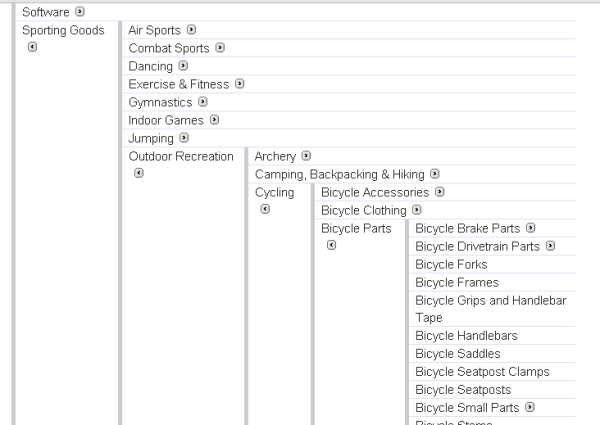
There are a lot of moving parts to a successful move from brick-and-mortar to e-commerce, and one of the most important components of a successful transition is adapting to the world of remote customer service and the challenges of dealing with a much wider array of customers who are potentially thousands of miles from your shop. Yesterday, I talked about a hypothetical example and offered some general rules, but it only seems right to share some personal challenges I’ve encountered over my long years in e-commerce. This one, I’ve only ever told to a few friends in the bike business. This is about the one that got away.
About fourteen years ago, I was selling custom built bicycles on the Internet–as in, customers would choose each and every component they wanted on their bike, and my company–which was pretty much just me at the time–would create the bicycle, fine tune everything about it, partially disassemble it, and ship it to them.
Easy.
This was still a pretty volatile time in the world of mountain bikes. Rear suspension systems were still a relatively new concept to a lot of curious, but slightly terrified, people. Intense scrutiny over each pro and con of the various frames on the market was common in a way that it just isn’t any more, probably because the worst full-suspension frames these days tend to be light years better than what we had ten years ago. If you put your money on the wrong horse back then, you risked years of bouncing up and down like an idiot while friends on hardtails pointed and laughed. Suspension forks weren’t much better. Things that seem pretty unusual by today’s standards (like top caps shooting past your head on a descent), were realities to be considered. And of course riders were still in the early process of confronting (often violently) the new technology of hydraulic disc brakes. It was the best of times. It was the worst of times.
I put in very long hours on the phone and at the keyboard, discussing all of the new technologies with people. I compared single-pivots to Horst-links, Horst-links to faux-bars, closed hydraulic systems (remember those?) to open, that sort of thing. Endlessly.
How endlessly? I’ll admit I once fell asleep while talking with a customer. He was a really nice guy, and very smart and educated about all things bike, but also a bit of a self-debater, and my role on the phone was largely psychological. In my defense, this was a period of twelve-hour work days, often six or more days a week. Talk, e-mail, wrench, code website, sleep, repeat, but, in retrospect, I should never have put a couch in the shop, and should’ve known better than to try fielding a phone call on it. When I came back to, he was still talking, though, and hadn’t noticed I was gone, so we picked right back up where we’d left off like nothing had happened.
Unfortunately, there were other times when it probably would’ve been better to nap.
My experience with Parrot Boy began shortly after we’d expanded our building. I remember this because for many of the phone calls I remember sitting at the top of the steps up to the new second floor, looking down at the bikes on the showroom floor for inspiration and something like a will to live. I should point out here that this person had a strong aversion to e-mail, as I’ve come to find most people who frequently change their minds and can never recall the last discussion often do. There is a kind of advantage to e-mail, as it keeps a running journal of sorts of your progress, when you’re discussing various components and prices of components, but Parrot Boy was a talker. He didn’t just prefer we started each conversation over again and again from scratch as opposed to keeping a running record and making progress: he demanded it. He liked talking to me.
Let me clarify that: he liked asking me the same question three days in a row, to see if my response would change. So maybe he was keeping notes, just not the kind that let us work together. His approach was more to test me. Every day. For many days.
He particularly liked to quiz me on which suspension system I found the best. For what he was doing, which, as I recall, seemed to involve primarily well-groomed trails and pavement, but primarily long non-technical climbs–physical endeavors that demonstrated his superior virility. In fact, it wasn’t really sufficient that we only discussed bicycles. He thought it important to the process to ensure I knew certain facts about his life, in order to recommend the optimum parts for his bike. One thing I was supposed to understand was that he wasn’t just living the American Dream*; he was dominating it. (For anyone under the age of 30, “the American Dream” was this weird belief that each of us could make our lives better in our lifetime, and that our children’s lives would be even better still–a weird idea we used to have back when there were drive-ins.) Parrot Boy was what would come to be known many years later as a “player.” It was important that I understood that.
To reinforce this notion, he offered specific facts about himself: his house and car were, of course, spectacular. Not just the results of affluence, but somehow magical, the way you’d imagine Steve Job’s toothbrush was probably something really special. All his shit was like that, and this bike would need to be like that, too, because he would be the owner.
Special. I understood this. I got this a lot, of course.
But pretty early into our discussions “special” began to take some odd turns. The pieces of information he felt compelled to share with me became more and more challenging to interpret. Attempting to explain a nuance about his needs, he once pointed out to me (and I remember this one nearly verbatim):
I only date beautiful Asian women, and I insist on choosing their clothes.”
My hope is that there are customer service professionals or bike shop sales rats reading this who’d like to venture a guess as to its relevance. So many years later, I’m still baffled as to how the specifics there relate to purchasing a bicycle, though it certainly did tell me a lot about him.
But these little glimpses into Parrot Boy’s hierarchy of needs and overall reason for being (and there were many) didn’t break my back. They’re the parsley around the T-bone and potatoes that led to my decision–scary as it was at the time–to recommend this customer not purchase a bike from me. It took more than unsettling personal revelations to make that happen.
What happened was this: after hours of suspension system discussion, I ended up recommending a Santa Cruz Superlight for Parrot Boy. At some point I’d determined that simplicity was something he would value, and somehow something about the swingarm of the Superlight (what’s now a Superlight was called the Heckler back then) made sense. Color, as I recall, was also going to be a factor, and Santa Cruz offered something like eight-hundred combinations. So, after continually circling a final decision for about a week, I suggested we focus on this frame. I reiterated some whys, and Parrot Boy agreed. End of discussion for that day. He’d talk to me again tomorrow. Tomorrow we’d move to components.
Then Parrot Boy did something interested. He called Chris Cocalis, the owner of Titus, and asked him why I’d recommended another company’s bike. Why, Parrot Boy wanted Chris to tell him, had I recommended another brand over his brand’s bike (the Racer-X), and did Chris think the Santa Cruz was better?
Chris gave me a call.
In business, there are difficult phone calls, and then there are difficult phone calls. I consider Chris, now at the helm of Pivot Cycles, a friend. I have a lot of respect for the guy, and I tend to personally ride his bikes because I like them. We’ve worked together in the same industry for a bunch of years, and I’ve sold his bikes to a lot of people. Whenever he thinks I’ve fucked up, he’s let me know, and whenever I think he’s fucked up, I’ve let him know. That doesn’t always happen, and I’m really grateful there are guys like Chris in the bike business. We worked things out on that phone call.
I can still remember the exact way I sat at the top of my stairs, my bike build area behind me, to take Parrot Boy’s next call. He was running at the mouth even more than usual. It’s possible Chris had let him know that he’d be giving me a call, but, for whatever reason, Parrot Boy was talking a blue streak for a good three or four minutes. When he did finally stop, this is what I asked him:
“Are you just evil?”
There was more–I’d let him know I’d spoken with Chris, and that I’d made a recommendation to him, based on my interpretation of his criteria, and that–as I’d mentioned many times previously–there are a lot of frames out there, and what I recommend for one person can be totally different from what I’d suggest for another. It’s all based on the individual’s needs, and I’d thought he matched up best for the Santa Cruz. “Why would you do that, though? Call the company and tell them I recommended somebody else’s bike and ask them why?” I’d asked him. Then the part about being evil.
I’d never called a customer “evil” before, and certainly didn’t after that. The teaching moment here is that I honestly should have cut this guy loose much, much sooner. I realized that now, as I was sitting there, head in hand, eyes closed, talking to him. I did not want to build a bike for this guy. I fucking obsessed about building bikes. I took it very seriously. I put everything I had into every bike. At that moment on the phone with him, I wasn’t thinking the least bit rationally. If I were an artist, would I sell a painting to motherfucking Hitler, even if I were starving? No, I abso-fucking-lutely would not. That sort of thinking.
There was no yelling or anything. I just said what I said, pretty calm, considering. He was a little rattled at first, taken aback. I could hear him over the blood pounding in my own head. He was explaining that he wanted the truth, and I was asking if he honestly believed the owner of Titus would tell him, “Yeah, sure, the Santa Cruz is just a superior product–any other questions?” I was telling him that I could not figure out what he thought would happen. He was just trying to get the most for his money, he’d said, and find out as much as he could.
That wasn’t the last phone call I had with Parrot Boy. In fact, any chance of working with him ended up breaking down entirely once he got to selecting his gearing, which I pointed out was not going to shift particularly well (it was something like a 22-34-46-tooth titanium (no ramps or pins) setup with an Action Tec rear cassette (that lacked machining and came with a roller that replaced your upper pulley and shifted like total ass). I was honest with him and told him what he was thinking of doing was the type of thing you’d think you wanted, until you actually had it, and found out how frustrating it was to try to shift. At lot of places would have loved to sell it all to him, because it all cost a fortune and markup was great, but even then I realized when a customer’s disappointed in the end, what you made on the sale really doesn’t matter. I wanted him to know that, no matter how well I got it to shift, there were other things out there that would shift better. If he didn’t shift a lot, no problem, but I thought he should know. I went into detail, too, explaining how the derailleur would have to be really high with the 46-tooth (I might’ve even been a 48-tooth, come to think of it), and that this would put it really height above the 22-tooth small ring.
He insisted that was what he wanted, and that I would be able to make it work. I told him no.
I told him I didn’t want to build the bike, because I thought he’d be disappointed. I told him I could recommend some other builders that I thought would do the build for him, but that I couldn’t stand behind the finished product, so I unfortunately had to pass.
Parrot Boy freaked the fuck out. He told me, among other things, that he was going to sue me. He was going to sue me for not building him a bicycle. He sued people, he let me know. That was the kind of thing he did, and then, suddenly, we were back in the land of buying clothes for Asian women. He told me he was going to come after me with “Internet lawyers.” Had I ever heard of Internet lawyers, he wanted to know, because I would see what they were like soon enough.
I’d not heard of “Internet lawyers,” no. Maybe they were like werewolves or something. Who the fuck knew? But I still refused to build his bike, confident in at least two things:
1. Parrot Boy was completely batshit crazy.
2. My life would be better if I didn’t.
I was unyielding, and wished him luck. I told him I wished that I could help him, but it was clear that he’d be better served elsewhere. Good day, sir.
Later, I came to find out that he’d sued the company who built the hopeless piece of shit bike.
We’ve really gone long enough without an explanation for the name, though, right? Parrot Boy’s phone calls to me would frequently be interrupted with strange sounds, muffled and not so muffled squeaks and squawks. For a while I thought he had a tick of some kind, a form of Tourette’s (I also had a customer who did, but that turned out not to be the case here), but then I began to notice that he would also seem to talk to himself, saying comforting things, little reassurances. As it turned out, he preferred to call me when his pet parrot was sitting on his shoulder. Once he shared this information, many other things began to make sense, though only now, so many years later, do I find myself questioning the reality of the parrot. I think it’s at least as likely the parrot was a stuffed animal, or entirely imaginary.
Either way, this was one from my case files. One of the few I let get away.








